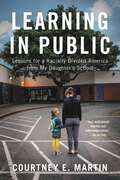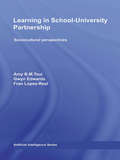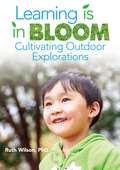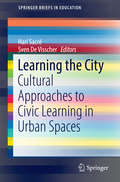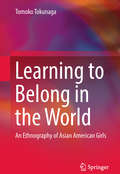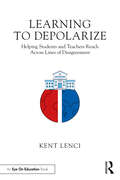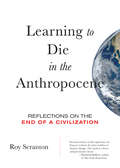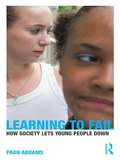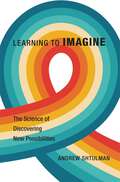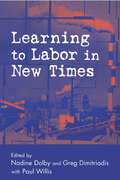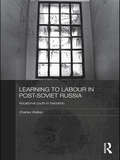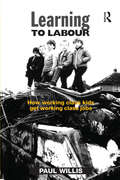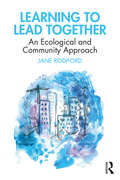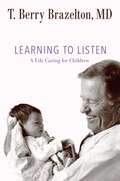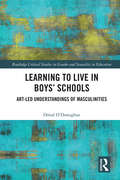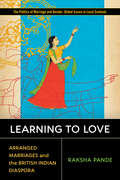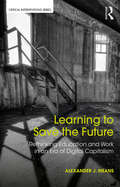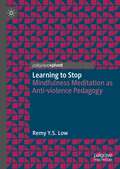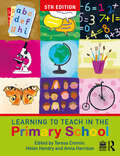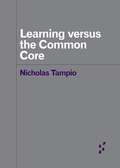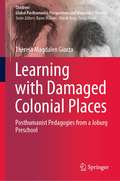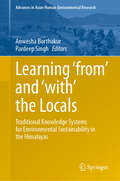- Table View
- List View
Learning in Public: Lessons for a Racially Divided America from My Daughter's School
by Courtney E. MartinOne mother&’s story of enrolling her daughter in a local public school, and the surprising, necessary lessons she learned with her neighbors.From the time Courtney E. Martin strapped her daughter, Maya, to her chest for long walks, she was curious about Emerson Elementary, a public school down the street from her Oakland home. She learned that White families in their gentrifying neighborhood largely avoided the majority-Black, poorly-rated school. As she began asking why, a journey of a thousand moral miles began. Learning in Public is the story, not just Courtney&’s journey, but a whole country&’s. Many of us are newly awakened to the continuing racial injustice all around us, but unsure of how to go beyond hashtags and yard signs to be a part of transforming the country. Courtney discovers that her public school, the foundation of our fragile democracy, is a powerful place to dig deeper. Courtney E. Martin examines her own fears, assumptions, and conversations with other moms and dads as they navigate school choice. A vivid portrait of integration&’s virtues and complexities, and yes, the palpable joy of trying to live differently in a country re-making itself. Learning in Public might also set your family&’s life on a different course forever.
Learning in School-University Partnership: Sociocultural Perspectives
by Gwyn Edwards Amy B.M. Tsui Fran Lopez-Real Tammy Kwan Doris Law Philip Stimpson Rosina Tang Albert WongThis volume looks at school-university partnerships from sociocultural perspectives of learning that view participation in social practice as fundamental to the process of learning. Its two major themes – school-university partnership and sociocultural and social theories of learning – have both been treated extensively in the literature. It is the bringing together of these two themes that makes this book unique. In this examination of an evolving model of school-university partnership, the Unified Professional Development Project in Hong Kong, the authors analyze the learning that takes place as the participants (student-teachers, mentor teachers, and university supervisors) mutually engage in the enterprise of improving teaching and learning in schools, developing shared practices, and creating new communities of practice. Although it describes one specific context, the book is not just about this locale. Rather, the Unified Professional Development Project is used as a context for theorizing more generally a social theory of learning for school-university partnerships that is relevant to any other similar context. This book will interest teacher educators, researchers in teacher education and teacher development, policy makers, and school practitioners who are involved in school-university partnerships.
Learning is in Bloom: Cultivating Outdoor Explorations
by Ruth Wilson Gwendolyn Johnson Susan GuiterasThe movement to connect young children with nature continues to grow, as more parents and educators become passionate about bringing learning outdoors and letting children explore outside the bounds of traditional lessons. In the full-color Learning Is in Bloom, teachers and caregivers will find 40 hands-on activities effective in engaging young children in investigating nature, both indoors and outdoors, on the school grounds, and on excursions around the neighborhood. Through fostering a love of nature, the activities promote all areas of early childhood education and development.
Learning the City
by Hari Sacré Sven VisscherThis book explores a cultural understanding of cities and processes of civic learning by scrutinizing urban educational topics from a cultural studies perspective. This book approaches the city as a cultural fabric that consists of social, material and symbolic dimensions, and describes how civic learning is not an accidental outcome of cities but an essential component through which citizens coproduce the city. Through a combination of theoretical development and methodological reflection the chapters in the book explore three interrelated questions addressing the relationships between culture, learning and the city: How does civic learning appear in urban spaces? How does civic learning take place through urban spaces? How are urban spaces created as a result of civic learning?
Learning to Belong in the World: An Ethnography Of Asian American Girls
by Tomoko TokunagaThis book provides a complex and intricate portrayal of Asian American high school girls – which has been an under-researched population – as cultural meditators, diasporic agents, and community builders who negotiate displacement and attachment in challenging worlds of the in-between. Based on two years of ethnographic fieldwork, Tomoko Tokunaga presents a portrait of the girls’ hardships, dilemmas, and dreams while growing up in an interconnected world. This book contributes a new understanding of the roles of immigrant children and youth as agents of globalization and sophisticated border-crossers who have the power and agency to construct belonging and identity across multiple contexts, spaces, times, activities, and relationships. It has much to offer to the construction of educative communities and spaces where immigrant youth, specifically immigrant girls, can thrive.
Learning to Change Lives
by A. Ka TsangThe Strategies and Skills Learning and Development (SSLD) system is an action-oriented model for enabling clients in social work, health, mental health, and human services settings to address their needs and life goals. In Learning to Change Lives, author A. Ka Tat Tsang introduces SSLD's powerful framework and practice, which has been developed based on three decades of experience in psychotherapy, counselling, education, training, consultation, and community service.Learning to Change Lives provides detailed, step-by-step guidelines for SSLD intervention - starting with engagement with the client, assessment, translating problems into intervention plans, systematic learning and development of appropriate strategies and skills. Key practice procedures are described clearly and illustrated by case examples, specific instructions, and sample worksheets. Aimed at clinical practitioners, mental health professionals, social workers, and other human service professionals, this book can be used as a manual by practitioners and as a textbook for courses and training programs.
Learning to Depolarize: Helping Students and Teachers Reach Across Lines of Disagreement
by Kent LenciHow can schools shoulder some responsibility for depolarizing our fractured American society? In this provocative new book, Kent Lenci describes how educators can tackle the challenge of preparing students to communicate and collaborate across lines of deep disagreement—to face the political and ideological "other"—despite the conventional wisdom that schools should be apolitical. Topics covered include the causes and consequences of political polarization in our society, why schools must address the challenge head-on, bridge-building in the classroom, media literacy and social emotional learning as tools for depolarization, and partnering with parents across the divide. Each chapter offers current research as well as practical strategies and classroom anecdotes. Appropriate for teachers of all grade levels and subject areas, the book will help you reconsider your classroom and school’s role in forging a more depolarized future.
Learning to Die in the Anthropocene
by Roy Scranton"In Learning to Die in the Anthropocene, Roy Scranton draws on his experiences in Iraq to confront the grim realities of climate change. The result is a fierce and provocative book."--Elizabeth Kolbert, Pulitzer Prize-winning author of The Sixth Extinction: An Unnatural History"Roy Scranton lucidly articulates the depth of the climate crisis with an honesty that is all too rare, then calls for a reimagined humanism that will help us meet our stormy future with as much decency as we can muster. While I don't share his conclusions about the potential for social movements to drive ambitious mitigation, this is a wise and important challenge from an elegant writer and original thinker. A critical intervention."--Naomi Klein, author of This Changes Everything: Capitalism vs. the Climate Coming home from the war in Iraq, US Army private Roy Scranton thought he'd left the world of strife behind. Then he watched as new calamities struck America, heralding a threat far more dangerous than ISIS or Al Qaeda: Hurricane Katrina, Superstorm Sandy, megadrought--the shock and awe of global warming.Our world is changing. Rising seas, spiking temperatures, and extreme weather imperil global infrastructure, crops, and water supplies. Conflict, famine, plagues, and riots menace from every quarter. From war-stricken Baghdad to the melting Arctic, human-caused climate change poses a danger not only to political and economic stability, but to civilization itself . . . and to what it means to be human. Our greatest enemy, it turns out, is ourselves. The warmer, wetter, more chaotic world we now live in--the Anthropocene--demands a radical new vision of human life.In this bracing response to climate change, Roy Scranton combines memoir, reportage, philosophy, and Zen wisdom to explore what it means to be human in a rapidly evolving world, taking readers on a journey through street protests, the latest findings of earth scientists, a historic UN summit, millennia of geological history, and the persistent vitality of ancient literature. Expanding on his influential New York Times essay (the #1 most-emailed article the day it appeared, and selected for Best American Science and Nature Writing 2014), Scranton responds to the existential problem of global warming by arguing that in order to survive, we must come to terms with our mortality.Plato argued that to philosophize is to learn to die. If that's true, says Scranton, then we have entered humanity's most philosophical age--for this is precisely the problem of the Anthropocene. The trouble now is that we must learn to die not as individuals, but as a civilization.A war veteran, journalist, author, and Princeton PhD candidate, Roy Scranton has published in the New York Times, Wall Street Journal, Rolling Stone, Boston Review, and Theory and Event, and has been interviewed on NPR's Fresh Air, among other media.imes. This compressed, essential text offers both uncomfortable truths and unexpected joy."--McKenzie Wark, author of Molecular Red: Theory for the Anthropocene
Learning to Fail: How Society Lets Young People Down
by Fran AbramsDuring a decade of relative prosperity from the mid-1990s onward, governments across the developed world failed to crack one major issue – youth unemployment. Even when economic growth was strong, one young person in 10 in the United Kingdom was neither working nor learning. As the boom ended, the number of young people dropping out after leaving school – already acknowledged to be too high - began to rise at an alarming rate. As governments face up to the prospect of a new generation on the dole, this book examines the root causes of the problem. By holding a light to the lives and attitudes of eight young people, their families, their teachers and their potential employers, this book will challenge much of what has been said about educational success and failure in the past 20 years. For two decades, policy makers largely assumed schools were the key to ensuring young people got the best possible start in life. Yet for many children the path to failure began well before their first day at school. Through the stories of these young people, this book reveals how marginalised young people are let down on every step of their journey. Growing up in areas where aspiration has died or barely ever existed, with parents who struggle to guide them on life in the 21st century, they are let down by schools where teachers underestimate them, by colleges and careers advisers who mislead them and by an employment market which has forgotten how to care or to nurture. Learning to Fail goes behind the headlines about anti-social behaviour, drugs and teenage pregnancy to paint a picture of real lives and how they are affected by outside forces. It gives a voice to ordinary parents and youngsters so they can speak for themselves about what Britain needs to do to turn its teenage failures into a success story.
Learning to Forget: The Anti-Memoirs of Modernity
by Dipankar GuptaDiscussing the difference between modernization and westoxication, the book is a phenomenological treatment that is abstract and yet illustrative, when discussing issues such as affirmative action, citizenship, and development in India.
Learning to Imagine: The Science Of Discovering New Possibilities
by Andrew ShtulmanAn award-winning cognitive scientist offers a counterintuitive guide to cultivating imagination.Imagination is commonly thought to be the special province of youth—the natural companion of free play and the unrestrained vistas of childhood. Then come the deadening routines and stifling regimentation of the adult world, dulling our imaginative powers. In fact, Andrew Shtulman argues, the opposite is true. Imagination is not something we inherit at birth, nor does it diminish with age. Instead, imagination grows as we do, through education and reflection.The science of cognitive development shows that young children are wired to be imitators. When confronted with novel challenges, they struggle to think outside the box, and their creativity is rigidly constrained by what they deem probable, typical, or normal. Of course, children love to “play pretend,” but they are far more likely to simulate real life than to invent fantasy worlds of their own. And they generally prefer the mundane and the tried-and-true to the fanciful or the whimsical.Children’s imaginations are not yet fully formed because they necessarily lack knowledge, and it is precisely knowledge of what is real that provides a foundation for contemplating what might be possible. The more we know, the farther our imaginations can roam. As Learning to Imagine demonstrates, the key to expanding the imagination is not forgetting what you know but learning something new. By building upon the examples of creative minds across diverse fields, from mathematics to religion, we can consciously develop our capacities for innovation and imagination at any age.
Learning to Labor in New Times (Critical Social Thought)
by Paul Willis Nadine Dolby Greg DimitriadisLearning to Labor in New Times foregrounds nine essays which re-examine the work of noted sociologist Paul Willis, 25 years after the publication of his seminal Learning to Labor, one of the most frequently cited and assigned texts in the cultural studies and social foundations of education.
Learning to Labour in Post-Soviet Russia: Vocational youth in transition (BASEES/Routledge Series on Russian and East European Studies)
by Charles WalkerThis book explores the changing nature of growing-up working-class in post-Soviet Russia, a country dislocated by the experience of neo-liberal economic reform. Based on extensive ethnographic research in a provincial Russian region, it follows the experiences of vocational education graduates whose colleges continue to channel them into the ailing industrial and agricultural sectors. Rather than settling for transitions into ‘poor work’, the book shows how these young men and women develop a range of strategies aimed at overcoming the poverty of opportunity available to them in traditional enterprises, pursuing instead emerging opportunities in higher education, jobs in the new service sector and the prospect of migration. Drawing on a range of theoretical perspectives, Charles Walker analyses these strategies and their significance for wider processes of social change and social stratification in post-Soviet Russia.
Learning to Labour: How Working Class Kids Get Working Class Jobs
by Paul WillisThis book which has now established itself as a classic study of working class boys describes how Paul Willis followed a group of 'lads' as they passed through the last two years of school and into work. The book explains that for 'the lads' it is their own culture which blocks teaching and prevents the realisation of liberal education aims. This culture exposes some of the contradictions within these formal aims and actually supplies the operational criteria by which a future in wage labour is judged. Paul Willis explores how their own culture can guide working class lads on to the shop floor. This is an uncompromising book which has provoked considerable discussion and controversy in educational circles throughout the world - it has been translated into Finnish, German, French, Swedish, Japanese and Spanish.
Learning to Lead Together: An Ecological and Community Approach
by Jane RiddifordNever before has there been such strong recognition of the importance of community-based green spaces to local communities and urban redevelopment. This book is an autoethnographic account of the challenges and breakthroughs of learning to lead together. The interwoven stories provide first-hand, evocative examples of how an ecological and community approach to organisational development and urban regeneration helped shift the business as usual paradigm. It will help you identify and step beyond individualistic and ‘heroic’ notions of leadership, and will inspire you to find your own way of embracing natural and shared authority. The book focuses on the experiences of developing an environmental education charity in London; Global Generation. It shows how action research, nature practice and storytelling has successfully grown shared purpose, trust and collaboration, both within Global Generation and in the wider community. The style and structure of the book reflects the participatory approach that it presents. The author, Jane Riddiford, deliberately challenges the norms of authorship, which is shaped by the dominant Western narrative – objective, authorless and ‘othered’. This book goes beyond this narrow framework, combining different styles of writing, including traditional and autobiographical storytelling, diary entries and co-writing. Along with practice accounts of what happened, challenges raised and lessons learned, each chapter will also include other people’s descriptions of their experience of being involved in the process.
Learning to Listen: A Life Caring for Children (A Merloyd Lawrence Book)
by T. Berry BrazeltonFrom his childhood in Waco, Texas, where he took expert care of nine small cousins while the adults ate Sunday lunch, to Princeton and an offer from Broadway, to medical and psychoanalytic training, to the exquisite observations into newborn behavior that led babies to be seen in an entirely new light, Dr. T. Berry Brazelton's life has been one of innovation and caring. Known internationally for the Touchpoints theory of regression and growth in infants and young children, Brazelton is also credited for bringing the insights of child development into pediatrics, and for his powerful advocacy in Congress. In Learning to Listen, fans of Brazelton and professionals in his field can follow both the roots of a brilliant career and the evolution of child-rearing into the twenty-first century.
Learning to Live Together Harmoniously: Spiritual Perspectives from Indian Classrooms (Spirituality, Religion, and Education)
by Jwalin PatelThis book calls for an expanded vision of holistic education that emphasizes togetherness and harmony through the discovery of oneself, others, and the larger society. It brings together teachers’ voices, experiences, and practices for such an education with Southern Knowledge, philosophy and ideologies proposed by Indian philosophers and spiritual leaders like Aurobindo, the Dalai Lama, Gandhi, Krishnamurti, and Tagore. The book reconceptualizes and extends UNESCO's "Learning To Live Together" to emphasize "Learning to Live Together Harmoniously" (LTLTH) and develops a novel conceptual framework for it. The book also explores how LTLTH can be translated into practice; calling for a continuum of harmonious lived experiences created through experiential and project based pedagogy, systems and processes for autonomy and autonomous behaviour regulation, empathetic teacher student relations, schoolwide ethos of harmonious living, and teachers’ ways of living and being.
Learning to Live in Boys’ Schools: Art-led Understandings of Masculinities (Routledge Critical Studies in Gender and Sexuality in Education)
by Donal O'DonoghueThis book is about boys’ experiences of being educated in independent single-sex schools in Canada. These experiences, which are oftentimes attributed to particular places and moments at school, reveal ways in which school places are both "companionable" and "influential" in how boys become available to themselves and others as they pursue the possibility of becoming somebody. Curious about how masculinities show up in places at school and studying the sorts of gendered subjectivities that such places invite, entice, support and deny, the book extends beyond traditional ways of thinking and writing about the production of masculinities in education by introducing a different set of conceptual orientations and inquiry practices, including post-masculinities, weak theory, and art-led research and thought practices.
Learning to Love: Arranged Marriages and the British Indian Diaspora (Politics of Marriage and Gender: Global Issues in Local Contexts)
by Raksha PandeLearning to Love moves beyond the media and policy stereotypes that conflate arranged marriages with forced marriages. Using in-depth interviews and participant observations, this book assembles a rich and diverse array of everyday marriage narratives and trajectories and highlights how considerations of romantic love are woven into traditional arranged marriage practices. It shows that far from being a homogeneous tradition, arranged marriages involve a variety of different matchmaking practices where each family tailors its own cut-and-paste version of British-Indian arranged marriages to suit modern identities and ambitions. Pande argues that instead of being wedded to traditions, people in the British-Indian diaspora have skillfully adapted and negotiated arranged marriage cultural norms to carve out an identity narrative that portrays them as "modern and progressive migrants"–ones who are changing with the times and cultivating transnational forms of belonging.
Learning to Save the Future: Rethinking Education and Work in an Era of Digital Capitalism (Critical Interventions)
by Alexander J. MeansMainstream economists and Silicon Valley entrepreneurs claim that unfettered capitalism and digital technology can unlock a future of unbounded prosperity, create endless high paying jobs, and solve the world’s vast social and ecological problems. Realizing this future of abundance purportedly rests in the transformation of human potential into innovative human capital through new 21st century forms of education. In this new book Alex Means challenges this view. Stagnating economic growth and runaway inequality have emerged as the ‘normal’ condition of advanced capitalism. Simultaneously, there has been a worldwide educational expansion and a growing surplus of college-educated workers relative to their demand in the world economy. This surplus is complicated by an emerging digital revolution driven by artificial intelligence and machine learning that generates worker displacing innovations and immaterial forms of labor and valorization. Learning to Save the Future argues that rather than fostering mass intellectuality, educational development is being constrained by a value structure subordinated to 21st century capitalism and technology. Human capabilities from creativity, design, engineering, to communication are conceived narrowly as human capital, valued in terms of economic productivity and growth. Similarly, global problems such as the erosion of employment and climate change are conceived as educational problems to be addressed through business solutions and the digitalization of education.?This thought-provoking account provides a cognitive map of this condition, offering alternatives through critical analyses of education and political economy, technology and labor, creativity and value, power and ecology.
Learning to Stop: Mindfulness Meditation as Anti-violence Pedagogy
by Remy Y.S. LowThis book is a philosophical and historical study that explores how meditative practices for cultivating mindfulness can be regarded as a unique form of education against violence—one that emphasizes stopping and contemplation as a necessary precursor to action. It brings together the idiosyncratic but insightful musings on violence by Slovenian philosopher Slavoj Žižek with recent research on mindfulness and violence as a lens. Using this lens, it looks at two exemplary educators and how they taught mindfulness meditation as a way of resisting the types of violence they and their students faced: the Vietnamese Zen teacher Thich Nhat Hanh amidst the brutality of the Second Indochina War (1955-1975), and the African-American studies professor and cultural critic bell hooks in the face of systemic oppression in the United States of the 1980s.
Learning to Teach in the Primary School (Learning to Teach in the Primary School Series)
by Teresa Cremin Helen Hendry Anna HarrisonHow do you become an effective primary school teacher? What do you need to be able to do? What do you need to know?Flexible, effective and creative primary school teachers require subject knowledge, an understanding of their pupils and how they learn, a range of strategies for managing behaviour and organising environments for learning, and the ability to respond to dynamic classroom situations.The fifth edition of this bestselling textbook has been fully updated with the latest research and initiatives in the field, as well as the most recent curriculum and policy changes across the UK. It features two new co-editors and 13 new chapters and enhanced accessibility throughout. New or completely rewritten chapters have been included on: Reading curriculum Writing curriculum Maths curriculum Science curriculum Arts-enriched curriculum Humanities curriculum Adaptive teaching Education and wellbeing Education for sustainability Applying for jobs and preparing to be an ECT A selection of extra tasks have been woven throughout, with an emphasis on innovative, reflective practice, and new ‘vivid examples’ bring each chapter’s argument to life in a classroom context.Providing a comprehensive but accessible introduction to teaching and learning in the primary school, covering everything a trainee needs to know in order to gain QTS, this accessible and engaging textbook is essential reading for all students training to be primary school teachers.This textbook is supported by a free companion website with additional resources for instructors and students and an accompanying series of books on Teaching Creatively across the curriculum.
Learning versus the Common Core (Forerunners: Ideas First #55)
by Nicholas TampioAn open challenge to Common Core&’s drive for uniformity Nicholas Tampio watched as his kindergartner&’s class shifted from one where teachers, aides, parents, and students worked hard to create a rewarding educational experience to one in which teachers delivered hours-long lectures using packaged lesson plans. Learning versus the Common Core explains how standards-based education reform is transforming nearly every aspect of public education by looking closely at the standards, the agenda of people pushing standards-based reform, and how these fit within a global pattern of education reform. With a nod to the philosophy of John Dewey, Tampio concludes with a vision of what democratic education can look like today—and how people can form rhizomatic alliances across different political and ethical backgrounds to fight the Common Core.Forerunners: Ideas First Short books of thought-in-process scholarship, where intense analysis, questioning, and speculation take the lead
Learning with Damaged Colonial Places: Posthumanist Pedagogies from a Joburg Preschool (Children: Global Posthumanist Perspectives and Materialist Theories)
by Theresa Magdalen GiorzaThis book offers a close and detailed account of the emergent and creative pedagogies of children learning together in a small, not-for-profit preschool, and the entangled becomings of their carers as well as the researcher–artist–author. The mutually affecting and inseparable realities of the ‘material’ and the ‘discursive’ are made visible through lively and sensual pedagogical invention by a group of five-year olds in the inner-city preschool which is located in Johannesburg, South Africa. These small, local stories are recognized in their emergence with global geopolitical realities. The author makes a valuable contribution to post-qualitative research through the use of visual research methods and non-representational approaches to working with knowledge. The book draws on the constantly evolving practices of Philosophy for Children (P4C) and Reggio Emilia both as pedagogical tools and as research methods. Photographs and stills from video footage provide a sense of the relatively modest material environment of the school. The book celebrates the considerable richness of the involvement of the children and the enormous possibilities offered by the world both inside and outside of the classroom when an enquiry-led art-based pedagogy is followed. Drawings and other products created by the children in the study offer valuable insight into the depth and complexity of their engagement with their worlds, both individual and collaborative.
Learning ‘from’ and ‘with’ the Locals: Traditional Knowledge Systems for Environmental Sustainability in the Himalayas (Advances in Asian Human-Environmental Research)
by Pardeep Singh Anwesha BorthakurThis book aims to capture the fading traditional knowledge systems of local and indigenous communities in the Himalayas. As many of these practices are at risk of disappearing, the book serves as a valuable record. It encourages readers to reflect on the implications of such knowledge for environmental sustainability today. Focusing on one of the most crucial mountain ranges globally, the book emphasizes the importance of learning ‘from’ and ‘with’ the locals about their lived experiences in the Himalayas. Understanding their unique set of traditional knowledge and technologies is crucial for building climate resilience and effective environmental management. With contributions from experts across the Himalayan region, the book strives for a comprehensive grasp of environmental challenges and potential solutions. Beyond documentation, the goal is to explore opportunities for integrating traditional knowledge with modern scientific approaches. Recognizing the urgency, the book advocates for the preservation of local and indigenous knowledge to address the ongoing global environmental crisis.
